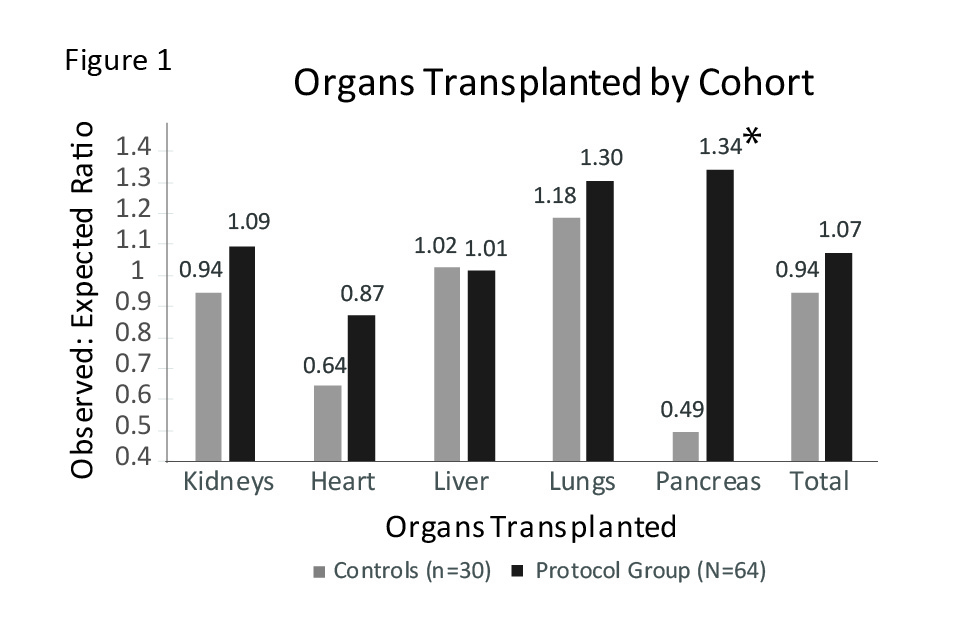A Stroke Volume-Based Fluid Resuscitation Protocol Decreases Vasopressor Support and Increases Organ Yield in Brain-Dead Donors
G. F. Marklin
Mid-America Transplant, St Louis, MO
Meeting: 2020 American Transplant Congress
Abstract number: 69
Keywords: Brain death, Donation, Donors, unrelated, Outcome
Session Information
Session Name: Deceased Donor Intervention and Management Research
Session Type: Oral Abstract Session
Date: Saturday, May 30, 2020
Session Time: 3:15pm-4:45pm
 Presentation Time: 3:27pm-3:39pm
Presentation Time: 3:27pm-3:39pm
Location: Virtual
*Purpose: Brain-dead donors are frequently hypovolemic and hypotensive requiring vasopressor support. The goal of fluid resuscitation is to increase perfusion and oxygen delivery and avoid tissue and pulmonary edema. Goal-directed fluid therapy in critically ill patients has been shown to have favorable outcomes. The optimal strategy for fluid replacement in organ donors is controversial. We studied a stroke volume-based fluid resuscitation and vasopressor weaning protocol prospectively on 64 hypotensive brain-dead donors, with a recent control cohort of 30 hypotensive donors treated without a protocol.
*Methods: Stroke volume was measured every 30 minutes for 4 hours by pulse contour analysis or esophageal doppler. A 500 milliliter saline fluid bolus was infused over 30 minutes and repeated if the stroke volume increased by 10%. No fluid was infused if the stroke volume did not increase by 10%. If the stroke volume then decreased by 10% after receiving no fluid in the previous 30 minutes, the saline bolus was repeated. Vasopressors were weaned every ten minutes if the mean arterial pressure was greater than 65 mm Hg. Vasopressin was only used to control polyuria from diabetes insipidus with a target urine output 50-100 ml/hr and not as a vasopressor. Intravenous thyroxine was not used on any donor in the study.
*Results: The protocol and control group were well matched with an expected total organ yield of 3.14 versus 3.13, respectively (p=0.9) using the SRTR OPO organ yield calculator. The protocol group received 1937±906 milliliters intravenous fluid compared to 1323±919 milliliters in the control group (p=.003) Mean time on vasopressors was decreased from 957.6±586.2 to 176.3±82.2 minutes (p<.001). There were more organs transplanted per donor in the protocol group (3.39±1.52) than in the control group (2.93±1.44) (p<0.001). Donors in the protocol group were significantly more likely to have four or more organs transplanted than donors in the control group (OR=4.114, 95% CI=1.003-16.876). The overall O:E ratio for transplanted organs increased from 0.94 to 1.07 in the control and protocol groups respectively.The O:E for lungs, hearts, kidneys and pancreata all increased with the fluid protocol (see figure). Lung O:E increased from 1.18 to 1.30 suggesting there was no loss of lungs transplanted with aggressive fluid replacement.
*Conclusions: A goal directed fluid resuscitation and vasopressor weaning protocol in brain-dead donors decreased organ ischemia and increased organs transplanted, without sacrificing lung yield.
To cite this abstract in AMA style:
Marklin GF. A Stroke Volume-Based Fluid Resuscitation Protocol Decreases Vasopressor Support and Increases Organ Yield in Brain-Dead Donors [abstract]. Am J Transplant. 2020; 20 (suppl 3). https://atcmeetingabstracts.com/abstract/a-stroke-volume-based-fluid-resuscitation-protocol-decreases-vasopressor-support-and-increases-organ-yield-in-brain-dead-donors/. Accessed December 21, 2025.« Back to 2020 American Transplant Congress

